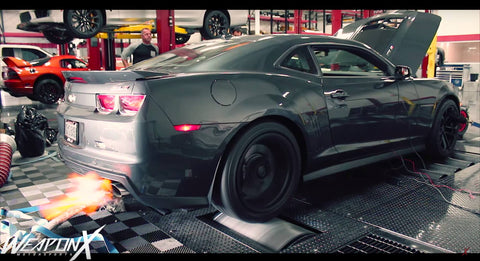
Project ZL1 Ready for Liftoff
Weapon-X Motorsports
Background
John brought in his 2013 ZL1 for an upgrade in power over stock. Having plenty of previous experience in the racing community and way of life, John made an easy decision to choose the ZL1 Alpha platform to build an awesome performing car. Straight out of the dealership the ZL1 boasts impressive horsepower and torque numbers, but its weight takes a little of the edge off of the LSA output. Cutting weight is one route, but who wants to sacrifice creature comforts? It makes much more sense to look at the other variable in the power to weight equation to increase performance.
Even in stock form, John's ZL1 put out some very stout numbers on our Mustang AWD-1100 dyno. We've seen quite a few near-stock ZL1s turning the rollers as low as 480rwhp all the way to the tune of 510rwhp. John's came in with a common aftermarket brand intake and put down 512rwhp and 493lbft of torque at our WXM Dyno Day, as seen below. Good base numbers indeed! Now on to the mods.

Modifications Installed
With the recent (and repeatable!) success of our in-house produced WXM 5” Intake for the 2016+ CTS-V (+29rwhp on stock calibration), we were very curious to see how it would do on the LSA powerplant. Fitment required a few tweaks, but our fabricators had it sorted and installed in a few hours. Without making any calibration changes (stock untouched PCM), the ZL1 made a healthy 19rwhp jump to 531rwhp. Torque was unchanged at 493lbft. However, the torque was able to hold out longer after peak torque (~4000rpm), which accounts for the jump in horsepower in the higher rpm range. You can see where the WXM Intake aids in breathing after 4800rpm in the graph below.


With an increase of almost 20rwhp with just an intake, we were very excited to see how well this Zl1 would respond to more boost pressure and a more free-flowing exhaust system. More boost would be realized via a 10.5” lower balancer pulley. In order to accommodate the anticipated level of added airflow, a set of Injector Dynamics 1000cc injectors were first on the modification list. Now you might be thinking 1000cc injectors are overkill at this stage, and you would be correct if we were only using 93 octane fuel...
Unless you ride a bicycle to work, you have to be aware of the potential power increases from ethanol-based fuels on boosted applications. With as little as a 40% e85/93 mixture we have seen power increases of around 30-50rwhp. In addition to the added power, ethanol burns cleaner and has a much higher octane rating than pump 93. You can almost have your cake and eat it too by extracting more horsepower and being safer to boot. John was definitely on board to add a GM Flex Fuel setup to his ZL1.

With the ID1000 injectors already on order, the only other point to address is the stock LSA fuel pump, which could use a boost in voltage to keep up with the demand of the engine on e85. We usually choose to go with the DSX Auxiliary Fuel Pump Kit in addition to the DSX Flex Fuel Kit because of its completeness and all the research that goes into making the kit about as plug-and-play as you can.
With the induction and fuel aspects of the build addressed, we can now move to what might be the most important staple of an aftermarket build: a throaty exhaust note that raises the hair on the back of your neck. As an enthusiast, there might be nothing more rewarding than hearing hell unleashed at the mat of the throttle (well, except maybe blower whine). John went with long tube headers, an offroad x-pipe, and catback from Stainless Works. The sound of this system is incredible and must be experienced in person to be truly appreciated.

Results and Final Thoughts
With part throttle tuning completed to get a feel for the new airflow characteristics of the combination, we were able to begin tuning for power. On 93 octane, the ZL1 laid down an impressive 623rwhp and 590lbft of torque. This is a gain of 111rwhp and 97lbft over what it was making initially when it arrived at our facility. The increase in torque was across the entire, and we mean entire, rev range. The stock tires will need to be retired soon in favor of more sticky rubber.

After a short cool-down period, the ZL1 was fed some corn, which brought up the ethanol percentage to the mid 40% range. We were limited by tank space to add more to bring up the percentage further. This will be addressed in the future. In the past, we have seen the gains from ethanol level off slightly after around 60%. After another dyno pull to adjust timing a bit, the ZL1 ended up laying down 658rwhp and 611lbft of torque. This is an increase of 35rwhp and 21 lbft of torque at only 40%. With ethanol levels raised to over 60%, the ZL1 would probably produce about 680rwhp and 625lbft if torque. Not bad for stock internals, stock cam, stock blower, and stock heads. At the end of the day, the ZL1 left with an additional 146rwhp and 118lbft of torque.

On the street, this ZL1 is now an absolute torque monster and can easily break the tires loose at any speed less than 70mph. It takes both skill and focus to pilot this machine in a straight line. The advantage to gaining power from ethanol and added boost is there is no loss in drivability. Other than the louder exhaust tone, there is no hint that this ZL1 makes 150rwhp over a stock vehicle and will drive like stock until the hammer is dropped.


